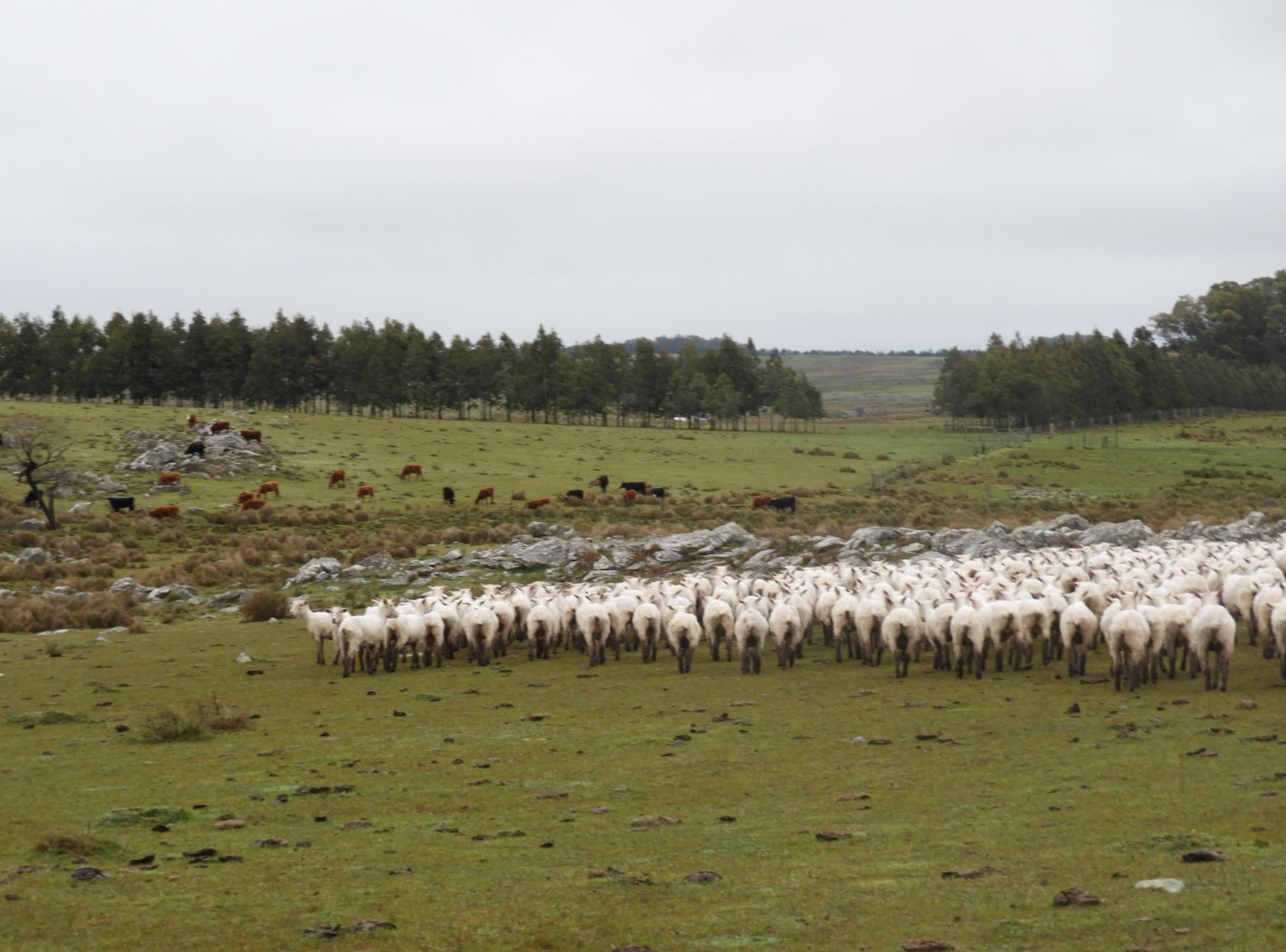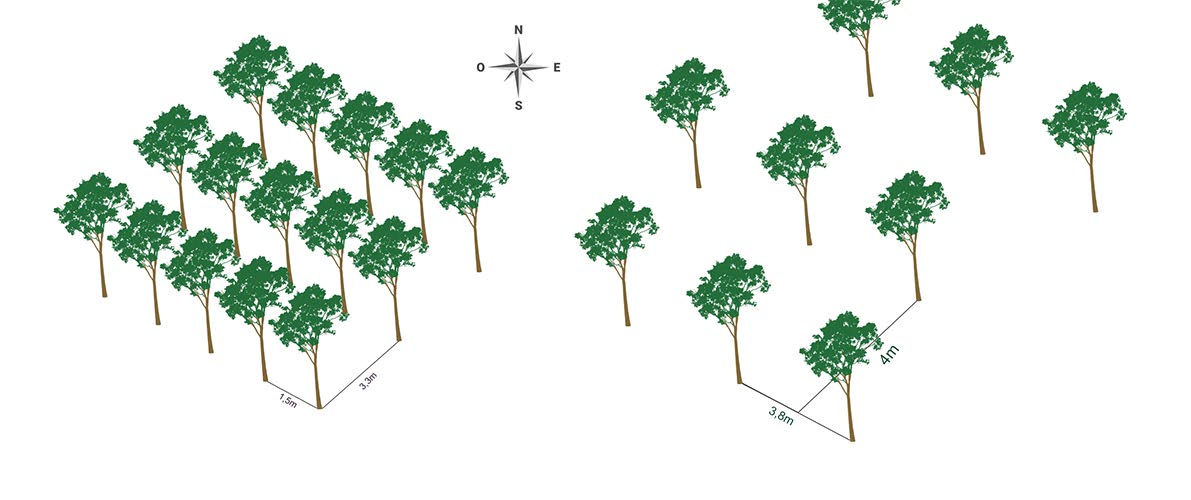Forests for shelter and shade on rural farms provide service to livestock and mitigate erosive processes, among other environmental services, and allow producers to diversify their income. The incorporation of forests on the land is an activity that requires specialized knowledge and skills, and financial resources (Mercer 2004). Despite the potential in terms of production and income improvements, the adoption of these systems is generally low in Latin America. Thus, in Chile, family producers present 4% afforested on average production of 50 ha (Sotomayor 2010). In Uruguay, an estimated of 9% of livestock is raised on forested land (Bussoni et al. 2017) and the forests for shelter and shade occupy 8% of the planted 1 million ha or 2.47 million acres (MGAP 2019). There are various incentives to introduce trees to livestock farms in Latin America (Calle et al. 2012) such as subsidies, credits, and payment for environmental services. From 2008 to 2013 (MGAP 2008; MGAP 2013), partial subsidies were granted to incorporate forests to improve the adaptation of livestock activity to climate variability and promote improvements in global farm productivity. This study utilizes five case studies to explore the potential of these forests to improve income, and 55 case studies to examine the main difficulties when implementing forests through semi-structured interviews.
All producers planted to provide shelter and shade to livestock, especially to moderate high summer temperatures (Figure 1); most producers do not consider harvesting the forests.
 Figure 1. Cattle and sheep farm with Eucalyptus dunnii plantations in the background
Figure 1. Cattle and sheep farm with Eucalyptus dunnii plantations in the background
Cattle and dairy farms located in the central and southeast of Uruguay make up the five cases. The farm sizes ranged from 120 to 530 ha. All cases were forested with Eucalyptus spp covering between 2 to 6 % of the farm areas. The forest designs were varied: roughly 1 ha islands and windbreaker curtains of 2-3 ha and 9 to 15 rows (Figure 2), all NE-SW oriented.
 Figure 2.- Planting frame: Flores (left) and Rocha (right).
Figure 2.- Planting frame: Flores (left) and Rocha (right).
Annual forest production ranged from 11 to 39 m3/ha/year of Mean Annual Increment (MAI) in 50 ha paddocks, representing an equity increase through the wood asset. Projected harvest ages ranged from 11 to 13 years from planting.
In a commercialization scenario, incorporation of forests represent an increase in the Equivalent Annual Income of 17-28% compared to livestock activity alone (Table 1).
Table 1.- Characteristics and results of the studied cases
|
Establishment (Department) |
Livestock orientation |
Property surface (ha) |
Forested proportion (%) |
Forest age (years) |
MAI (m3/ha/year) |
Equivalent annual income (US$/ha/year) |
|
Flores |
Rearing, Winter fattening, Sheep |
231 |
6 |
9 |
34 |
93 |
|
Rocha |
Winter fattening |
230 |
2 |
7.5 |
10 |
154 |
|
Lavalleja |
Rearing |
104 |
3 |
8.5 |
20 |
65 |
|
Flores (case 4/ 5) |
Dairy |
237/108 |
1 |
4 |
-- |
-- |
Economic-productivity depends on the genetic material used (which was not homogeneous in the studied cases) on the adequate soil work (e.g. subsoiling depth), and on the forested proportion. Family producers, who have evaluated the possibility of time-staggered harvesting, identify some limitations associated with low volume: lack of market access, and need to plan the harvest as a group. Subsidies received in the cases of forests for service were considered relevant to carry out the afforestation. Producers who incorporated afforestation for commercialization did so through some form of partnership with a forestry company. The areas affected by afforestation and closure are critical aspects in the family farm, therefore, it is necessary to investigate the arrangements that maximize the value obtained from wood and increase the grazing area. In all cases, interviewed producers showed a high degree of satisfaction with the forests. The main drawbacks include the site preparation, not having considered other design possibilities, nor having correctly assessed the effects of the chosen planting framework on the forage under canopy and the grazing area. Research that allows validating the systems that best meet producer demands should continue, improving the planning stage at the facility, in particular ant and weed control and tillage, and information access on design options for dual purposes (production and livestock services).
References
Bussoni A, Álvarez J, Cubbage F, et al (2017) Diverse strategies for integration of forestry and livestock production. Agrofor Syst 93:333–344. doi: 10.1007/s10457-017-0092-7
Calle Z, Murgueitio E, Chará J (2012) Integrating forestry, sustainable cattle-ranching and landscape restoration. Unasylva 63:31–40.
Mercer DE (2004) Adoption of agroforestry innovations in the tropics: A review. Agrofor Syst 61–62:311–328. doi: 10.1023/B:AGFO.0000029007.85754.70
MGAP (2019) Cartografía Forestal Nacional 2018. In: Minist. Ganad. Agric. y Pesca. https://www.gub.uy/ministerio-ganaderia-agricultura-pesca/comunicacion/publicaciones/informe-resultados-cartografia-forestal-nacional-2018.
MGAP (2008) Convocatoria para la presentación de planes forestales inclusión de bosques en sistemas de producción agropecuaria. In: Minist. Ganad. Agric. y Pesca. https://www.gub.uy/ministerio-ganaderia-agricultura-pesca/sites/ministerio-ganaderia-agricultura-pesca/files/2020-03/BASES LLAMADO AGROFORESTAL -.pdf.
MGAP (2013) Convocatoria para la presentación de planes agroforestales. Inclusión de bosques en sistemas de producción agropecuaria. In: Minist. Ganad. Agric. y Pesca. https://www.gub.uy/ministerio-ganaderia-agricultura-pesca/sites/ministerio-ganaderia-agricultura-pesca/files/2020-03/BASES LLAMADO AGROFORESTAL -.pdf.
Sotomayor A (2010) I Congreso Internacional Agroforestal Patagónico. In: Hepp Kuschel C, Sotomayor A (eds) Silvopastoral Systems, an alternative for sustainable development of the agriculture in Chile. Coyhaique, p 307

